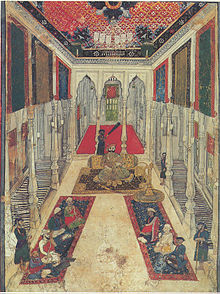
Back جاكير Arabic Джагір Byelorussian জায়গীর Bengali/Bangla Jagir Catalan Džagír Czech Jagir German Jagir Spanish جاگیر Persian जागीर Hindi Jagir Italian

A jagir (Persian: جاگیر, romanized: Jāgir), (Urdu: جاگیردار) also spelled as jageer,[1] was a type of feudal land grant in the Indian subcontinent at the foundation of its Jagirdar (Zamindar) system.[2][3]: 57–59 It developed during the Islamic era of the Indian subcontinent, starting in the early 13th century, wherein the powers to govern and collect tax from an estate was granted to an appointee of the state.[2] The tenants were considered to be in the servitude of the jagirdar.[4] There were two forms of jagir, one conditional, the other unconditional. The conditional jagir required the governing family to maintain troops and provide their service to the state when asked.[2][3]: 61–62 The land grant, called iqta'a, was usually for a holder's lifetime; the land reverted to the state upon the death of the jagirdar.[2][5]
The jagirdar system was introduced by the Delhi Sultanate,[2] and continued during the Mughal Empire,[6] but with a difference. In the Mughal times, the jagirdar collected taxes which paid his salary and the rest to the Mughal treasury, while the administration and military authority was given to a separate Mughal appointee.[7] After the collapse and takeover of Mughals, the system of jagirs was retained by Marathas, Charans, Rajput, Rajpurohit, Jat, and Sikh jat kingdoms, and later in a form by the British East India Company.[2][3]: 61–62 [8]
- ^ Davies, H. H.; Blyth, W. (1873). Report of the revised settlement of the pargunnahs of Umritsur, Sowrian & Turun Tarun of the Umritsur District [Report of the revised settlement of the parganas of Amritsar, Sowrian & Turun Tarun of the Amritsar District]. Lahore: Government Civil Secretariat Press. p. 29.
- ^ a b c d e f Jāgīrdār system: INDIAN TAX SYSTEM, Encyclopædia Britannica (2009)
- ^ a b c Roy, Kaushik (2015). Military Manpower, Armies and Warfare in South Asia. Taylor & Francis. pp. 57–59, pp. 61–62. ISBN 978-1-317-32127-9.
- ^ Qadeer, Mohammad (2006). Pakistan - Social and Cultural Transformations in a Muslim Nation. Routledge. pp. ix, 44. ISBN 978-1-134-18617-4.
- ^ Markovits, Claude (2004). A History of Modern India, 1480-1950. Anthem Press. p. 567. ISBN 978-1-84331-152-2.
- ^ Malik, Jamal (2008). Islam in South Asia: A Short History. BRILL Academic. p. 491. ISBN 978-90-04-16859-6.
- ^ Asher, Catherine B.; Talbot, Cynthia (2006). India Before Europe. Cambridge University Press. pp. 125–127. ISBN 978-0-521-80904-7.
- ^ Kaur, Madanjit (2008). Maharaja Ranjit Singh. Unistar. pp. 31–40. ISBN 978-81-89899-54-7.